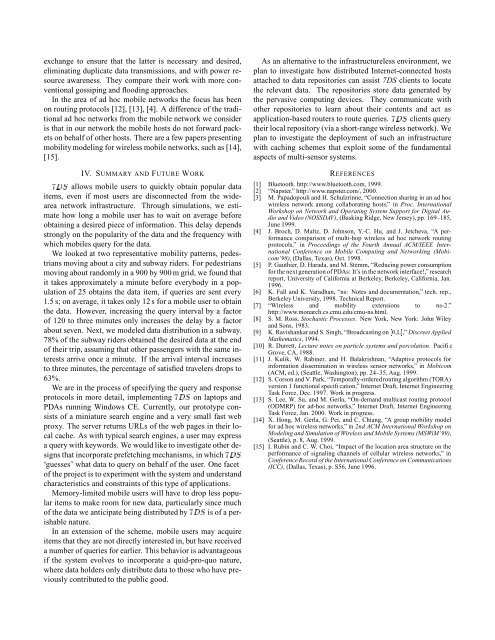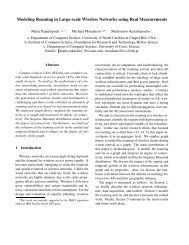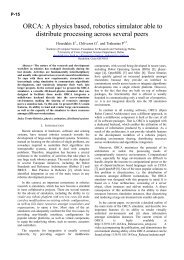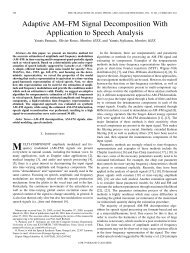Seven Degrees of Separation in Mobile Ad Hoc Networks - ICS
Seven Degrees of Separation in Mobile Ad Hoc Networks - ICS
Seven Degrees of Separation in Mobile Ad Hoc Networks - ICS
Create successful ePaper yourself
Turn your PDF publications into a flip-book with our unique Google optimized e-Paper software.
exchange to ensure that the latter is necessary and desired,<br />
elim<strong>in</strong>at<strong>in</strong>g duplicate data transmissions, and with power resource<br />
awareness. They compare their work with more conventional<br />
gossip<strong>in</strong>g and flood<strong>in</strong>g approaches.<br />
In the area <strong>of</strong> ad hoc mobile networks the focus has been<br />
on rout<strong>in</strong>g protocols [12], [13], [4]. A difference <strong>of</strong> the traditional<br />
ad hoc networks from the mobile network we consider<br />
is that <strong>in</strong> our network the mobile hosts do not forward packets<br />
on behalf <strong>of</strong> other hosts. There are a few papers present<strong>in</strong>g<br />
mobility model<strong>in</strong>g for wireless mobile networks, such as [14],<br />
[15].<br />
IV. SUMMARY AND FUTURE WORK<br />
allows mobile users to quickly obta<strong>in</strong> popular data<br />
¢¤£¦¥<br />
items, even if most users are disconnected from the widearea<br />
network <strong>in</strong>frastructure. Through simulations, we estimate<br />
how long a mobile user has to wait on average before<br />
obta<strong>in</strong><strong>in</strong>g a desired piece <strong>of</strong> <strong>in</strong>formation. This delay depends<br />
strongly on the popularity <strong>of</strong> the data and the frequency with<br />
which mobiles query for the data.<br />
We looked at two representative mobility patterns, pedestrians<br />
mov<strong>in</strong>g about a city and subway riders. For pedestrians<br />
mov<strong>in</strong>g about randomly <strong>in</strong> a 900 by 900 m grid, we found that<br />
it takes approximately a m<strong>in</strong>ute before everybody <strong>in</strong> a population<br />
<strong>of</strong> 25 obta<strong>in</strong>s the data item, if queries are sent every<br />
1.5 s; on average, it takes only 12 s for a mobile user to obta<strong>in</strong><br />
the data. However, <strong>in</strong>creas<strong>in</strong>g the query <strong>in</strong>terval by a factor<br />
<strong>of</strong> 120 to three m<strong>in</strong>utes only <strong>in</strong>creases the delay by a factor<br />
about seven. Next, we modeled data distribution <strong>in</strong> a subway.<br />
78% <strong>of</strong> the subway riders obta<strong>in</strong>ed the desired data at the end<br />
<strong>of</strong> their trip, assum<strong>in</strong>g that other passengers with the same <strong>in</strong>terests<br />
arrive once a m<strong>in</strong>ute. If the arrival <strong>in</strong>terval <strong>in</strong>creases<br />
to three m<strong>in</strong>utes, the percentage <strong>of</strong> satisfied travelers drops to<br />
63%.<br />
We are <strong>in</strong> the process <strong>of</strong> specify<strong>in</strong>g the query and response<br />
protocols <strong>in</strong> more detail, ¢¤£¦¥ implement<strong>in</strong>g on laptops and<br />
PDAs runn<strong>in</strong>g W<strong>in</strong>dows CE. Currently, our prototype consists<br />
<strong>of</strong> a m<strong>in</strong>iature search eng<strong>in</strong>e and a very small fast web<br />
proxy. The server returns URLs <strong>of</strong> the web pages <strong>in</strong> their local<br />
cache. As with typical search eng<strong>in</strong>es, a user may express<br />
a query with keywords. We would like to <strong>in</strong>vestigate other designs<br />
that <strong>in</strong>corporate prefetch<strong>in</strong>g mechanisms, <strong>in</strong> ¢¤£¦¥ which<br />
“guesses” what data to query on behalf <strong>of</strong> the user. One facet<br />
<strong>of</strong> the project is to experiment with the system and understand<br />
characteristics and constra<strong>in</strong>ts <strong>of</strong> this type <strong>of</strong> applications.<br />
Memory-limited mobile users will have to drop less popular<br />
items to make room for new data, particularly s<strong>in</strong>ce much<br />
<strong>of</strong> the data we anticipate be<strong>in</strong>g distributed ¢ £¦¥ by is <strong>of</strong> a perishable<br />
nature.<br />
In an extension <strong>of</strong> the scheme, mobile users may acquire<br />
items that they are not directly <strong>in</strong>terested <strong>in</strong>, but have received<br />
a number <strong>of</strong> queries for earlier. This behavior is advantageous<br />
if the system evolves to <strong>in</strong>corporate a quid-pro-quo nature,<br />
where data holders only distribute data to those who have previously<br />
contributed to the public good.<br />
As an alternative to the <strong>in</strong>frastructureless environment, we<br />
plan to <strong>in</strong>vestigate how distributed Internet-connected hosts<br />
attached to data repositories can assist 7DS clients to locate<br />
the relevant data. The repositories store data generated by<br />
the pervasive comput<strong>in</strong>g devices. They communicate with<br />
other repositories to learn about their contents and act as<br />
application-based routers to route ¢¤£¦¥ queries. clients query<br />
their local repository (via a short-range wireless network). We<br />
plan to <strong>in</strong>vestigate the deployment <strong>of</strong> such an <strong>in</strong>frastructure<br />
with cach<strong>in</strong>g schemes that exploit some <strong>of</strong> the fundamental<br />
aspects <strong>of</strong> multi-sensor systems.<br />
REFERENCES<br />
[1] Bluetooth. http://www.bluetooth.com, 1999.<br />
[2] “Napster.” http://www.napster.com/, 2000.<br />
[3] M. Papadopouli and H. Schulzr<strong>in</strong>ne, “Connection shar<strong>in</strong>g <strong>in</strong> an ad hoc<br />
wireless network among collaborat<strong>in</strong>g hosts,” <strong>in</strong> Proc. International<br />
Workshop on Network and Operat<strong>in</strong>g System Support for Digital Audio<br />
and Video (NOSSDAV), (Bask<strong>in</strong>g Ridge, New Jersey), pp. 169–185,<br />
June 1999.<br />
[4] J. Broch, D. Maltz, D. Johnson, Y.-C. Hu, and J. Jetcheva, “A performance<br />
comparison <strong>of</strong> multi-hop wireless ad hoc network rout<strong>in</strong>g<br />
protocols,” <strong>in</strong> Proceed<strong>in</strong>gs <strong>of</strong> the Fourth Annual ACM/IEEE International<br />
Conference on <strong>Mobile</strong> Comput<strong>in</strong>g and Network<strong>in</strong>g (Mobicom’98),<br />
(Dallas, Texas), Oct. 1998.<br />
[5] P. Gauthier, D. Harada, and M. Stemm, “Reduc<strong>in</strong>g power consumption<br />
for the next generation <strong>of</strong> PDAs: It’s <strong>in</strong> the network <strong>in</strong>terface!,” research<br />
report, University <strong>of</strong> California at Berkeley, Berkeley, California, Jan.<br />
1996.<br />
[6] K. Fall and K. Varadhan, “ns: Notes and documentation,” tech. rep.,<br />
Berkeley University, 1998. Technical Report.<br />
[7] “Wireless and mobility extensions to ns-2.”<br />
http://www.monarch.cs.cmu.edu/cmu-ns.html.<br />
[8] S. M. Ross, Stochastic Processes. New York, New York: John Wiley<br />
and Sons, 1983.<br />
[9] K. Ravishankar and S. S<strong>in</strong>gh, “Broadcast<strong>in</strong>g on ¡ ,L¢ ,” Discreet Applied<br />
Mathematics, 1994.<br />
[10] R. Durrett, Lecture notes on particle systems and percolation. Pacific<br />
Grove, CA, 1988.<br />
[11] J. Kulik, W. Rab<strong>in</strong>er, and H. Balakrishnan, “<strong>Ad</strong>aptive protocols for<br />
<strong>in</strong>formation dissem<strong>in</strong>ation <strong>in</strong> wireless sensor networks,” <strong>in</strong> Mobicom<br />
(ACM, ed.), (Seattle, Wash<strong>in</strong>gton), pp. 24–35, Aug. 1999.<br />
[12] S. Corson and V. Park, “Temporally-orderedrout<strong>in</strong>g algorithm (TORA)<br />
version 1 functional specification,” Internet Draft, Internet Eng<strong>in</strong>eer<strong>in</strong>g<br />
Task Force, Dec. 1997. Work <strong>in</strong> progress.<br />
[13] S. Lee, W. Su, and M. Gerla, “On-demand multicast rout<strong>in</strong>g protocol<br />
(ODMRP) for ad-hoc networks,” Internet Draft, Internet Eng<strong>in</strong>eer<strong>in</strong>g<br />
Task Force, Jan. 2000. Work <strong>in</strong> progress.<br />
[14] X. Hong, M. Gerla, G. Pei, and C. Chiang, “A group mobility model<br />
for ad hoc wireless networks,” <strong>in</strong> 2nd ACM International Workshop on<br />
Model<strong>in</strong>g and Simulation <strong>of</strong> Wireless and <strong>Mobile</strong> Systems (MSWiM’99),<br />
(Seattle), p. 8, Aug. 1999.<br />
[15] I. Rub<strong>in</strong> and C. W. Choi, “Impact <strong>of</strong> the location area structure on the<br />
performance <strong>of</strong> signal<strong>in</strong>g channels <strong>of</strong> cellular wireless networks,” <strong>in</strong><br />
ConferenceRecord <strong>of</strong> the International Conferenceon Communications<br />
(ICC), (Dallas, Texas), p. S56, June 1996.
















